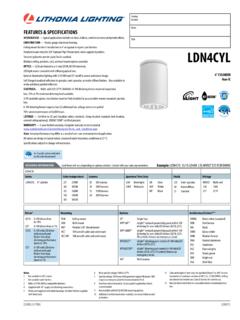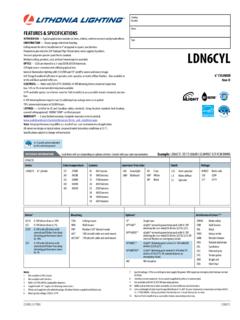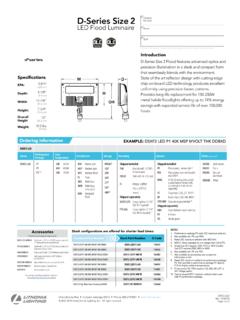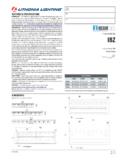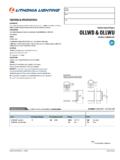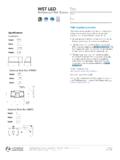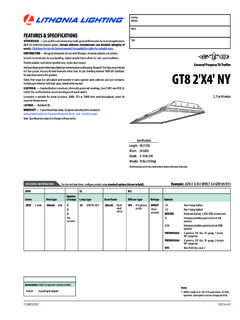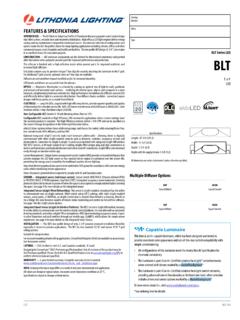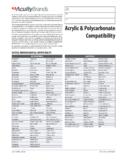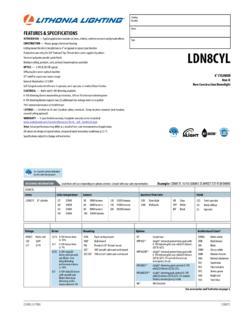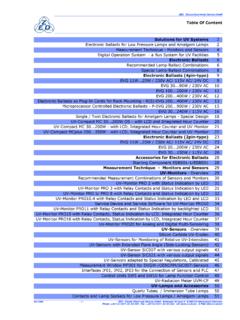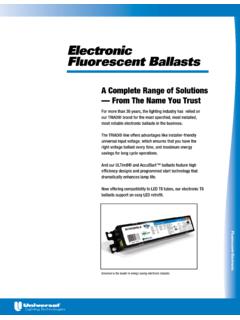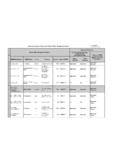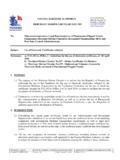Transcription of Ballast Characteristics
1 All electric discharge lamps are characterized as negativeresistance light sources. Therefore, they require supportdevices that limit the current when voltage is applied, toprevent the lamp from being destroyed. The Ballast is thedevice limiting the current , the Ballast provides the lamp with propervoltage to reliably start and operate the lamp throughout itsrated service life. A transformer integral to the Ballast circuitmatches voltage required for the lamp to the availablesupply and HID lamps exhibit several electrical char-acteristics that have important effects on ballasts. Thefollowing definitions will help explain those VoltageFluorescent Rapid Start lamps contain cathodes whichare preheated by the Ballast . A variety of fluorescent rapidstart ballasts are available to produce reliable starting forspecific ambient temperatures.
2 Mercury Vapor and mostMetal Halide lamps incorporate integral starting elec-trodes which allow the lamps to start at relatively lowvoltages in ambient temperatures ranging above -20 F (-30 C). High Pressure Sodium and low wattage (less than100 watts) Metal Halide lamps require separate electronicstarting devices (called ignitors ) which deliver a highvoltage pulse to establish the arc. HPS will start reliablyabove -40 F (-40 C) ambient temperatures. The pulserepeats each cycle with a maximum pulse width of 15microseconds. Once the lamp arc is established, theignitor drops out of the CurrentThis is the initial current available to the lamp duringwarm-up. If the current is incorrect, the lamp may not startor reach its rated operating performance. Rated lamp lifemay be CurrentThis is the rated current flow under nominal operatingconditions once the lamp arc has been established andis performing at rated levels.
3 The starting current maydiffer from the operating current. Care should be taken toload circuits to the highest load conditions (amperes).Normal power factor ballasts have higher starting cur-rents than operating. Low wattage (100 watts or less)Metal Halide and HPS lamps have the highest currentdemand during restrike (hot start).Fluorescent lamp operating voltage remains relativelyconstant throughout rated life. Lamp life, Ballast life, andlight output may be affected if the operating voltagevaries significantly from the voltage specified for theballast. In general, fluorescent ballasts should be oper-ated within 7 % of their rated voltage. Mercury Vaporand Metal Halide lamp operating voltage remains rela-tively constant throughout rated life, although lamp manu-facturing tolerances can allow for as much as 10%variance from nominal.
4 As a result, depending on the typeof Ballast being used, HID lamp wattage may vary consid-erably. High Pressure Sodium lamp operating voltagerises continually from initial installation until end of ballasts are designed to provide increased voltagerequirement to the lamp through rated life. For example,a 400W HPS lamp normally starts at 100 volts and increasesto 140 volts at end of WattageFluorescent lamps operate at rated wattage if the supplyvoltage is nominal and the lamp is operating at an ambienttemperature of 77 F (25 C). HID lamps operate at ratedwattage only if the lamp voltage and supply voltage isnominal. Lamp wattage, light output, and lamp life may beaffected if any conditions vary from FactorThis is the ratio of peak to RMS (root mean square) example, the crest factor of a true sine wave form Lamp manufacturers published data is based onlamps operated on a standard reactor Ballast with a factor.
5 Input voltage to a commercial Ballast is a sinewave, but the secondary voltage wave shape in theinductive and capacitive type Ballast is distorted, andtheir crest factors are higher than Tests indicate thatballasts with higher crest factors may result in deprecia-tion of lumen output or reduced lamp life. In general, amaximum lamp current crest factor of for fluorescentballasts is recommended. HID constant-wattage and con-stant-wattage autotransformer ballasts have a crest fac-tor of about Metal Halide and HPS ballasts HID lamp recommendations suggest a maximumcrest factor of for Mercury Vapor and for MetalHalide and FactorPower factor (phase between voltage and current) is theratio of line watts to line volts x line amps, expressed in apercentage. A high power factor (HPF) Ballast must havea power factor of at least 90% at nominal line voltage andlamp voltage.
6 In most cases, as the lamp and capacitorsage, the power factor will drop below 90%. A normal powerfactor (NPF) Ballast has a power factor below 90%, usuallyaround 50%. NPF compact fluorescent ballasts can be aslow as 28%. A normal power factor Ballast has almost twicethe line current as a high power factor Ballast , therebyrequiring larger wire sizes, breakers, switches, etc. for theequivalent connected load. Some power utilities mayassess a penalty charge for inefficient use of power dueto low power factor Frequency Interference (RFI)and Electromagnetic Interference (EMI)Electronic fluorescent ballasts generally operate at afrequency in excess of 20,000 hz to optimize lamp ballasts may feed back interference into thepower system resulting in interference with sensitiveelectronic equipment such as communications or dataprocessing equipment.
7 High quality electronic ballastsuse filters and enclosures to reduce conducted andBallast CharacteristicsOutdoorSheet#: TD-100 TD - 100radiated EMI to acceptable limits as specified by theFederal Communications Commission (FCC). Ballast Sound RatingsCore and coil ballasts may produce a slight hum due to themagnetic action within the Ballast . Fluorescent ballastsare sound rated by a letter code, A through D. An A soundrating is the quietest Ballast and is typically recommendedfor commercial applications. Because solid state elec-tronic ballasts do not contain a core and coil, they willgenerally operate quieter than magnetic Case TemperatureThe Ballast case temperature is affected by changes inambient temperature and voltage increase. Fluorescentballasts contain a Class P thermal switch which willdisconnect the Ballast if it exceeds 105 C.
8 Excessiveambient temperature or voltage supply may significantlyreduce the life of the DistortionAll ballasts generate harmonic currents of some magni-tude in the electrical distribution system. The ratio of RMS(root mean square) harmonic current to the RMS funda-mental current is the Total Harmonic Distortion or is often used to assess the ability of a fluorescentelectronic Ballast to control harmonic currents. The pro-posed ANSI standard for electronic ballasts specifies amaximum THD of 32%. Conventional magnetic ballasts aregenerally in the range of 10% to 20%. Most hybrid elec-tronic ballasts (containing both electronic and electro-magnetic components) fall into the area of 20% to 30%THD. Solid-state electronic ballasts (containing virtuallyall electronic components) are usually less than 10%. Ballast RegulationThis is the ability of a Ballast to control lamp wattage whensubjected to line voltage variation.
9 Consideration shouldbe given to line voltage variations expected on a givenelectrical system where HID lamps are used. Most newpower distribution systems are designed to provide 3%of nominal voltage. However, some systems, especiallyolder ones, may have variances up to 10% from Characteristics for various Ballast types arelisted in the Ballast data tables. Typically, the cost of aballast rises with the degree of regulation available. Thebetter the regulation, the higher the Dropout VoltageAll power distribution systems experience dips and peaksin line voltage as well as other transient conditions. Wellregulated systems seldom see voltage fluctuations of 20%or more. Be sure to check the primary dropout voltagerating on HID ballasts if voltage variations are of dips in excess of this rating may cause the lampsto extinguish and Characteristics 2002 Acuity Lighting Group, Inc.
10 3/02 Sheet #: TD-100 Lithonia LightingAcuity Lighting Group, LightingOne Lithonia Way, Conyers, GA 30012-3957 Phone: 770-922-9000 Fax: 770-918-1209In Canada: 1100 50th Ave., Lachine, Quebec H8T
